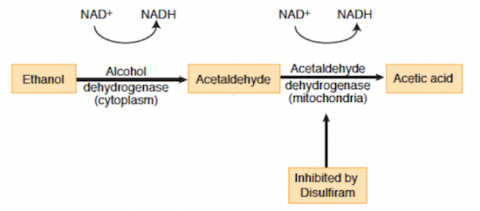If you’re preparing for the United States Medical Licensing Examination® (USMLE®) Step 1 exam, you might want to know which questions are most often missed by test-prep takers. Check out this example from Kaplan Medical, and read an expert explanation of the answer. Also check out all posts in this series.
This month’s stumper
A 33-year-old woman is brought to the physician because of profound nausea, vomiting, headache, sweating, tachycardia, blurred vision and dizziness. Her temperature is 37.8 °C (100 °F), pulse is 120 beats per minute, blood pressure is 104/66 mm Hg, and respirations are 19 per minute.
She says that she was out with a couple of friends having a few glasses of wine when she suddenly became ill. A review of her records shows that she was diagnosed with a duodenal ulcer, and triple-therapy treatment was started three days ago.
Which of the following drugs is most likely responsible for this patient's symptoms?
A. Amoxicillin.
B. Bismuth subsalicylate.
C. Metronidazole.
D. Omeprazole.
E. Tetracycline.
The correct answer is C.
Kaplan Medical explains why
Helicobacter pylori is an acid-labile, spiral-shaped, gram-negative rod that is catalase-positive, oxidase-positive, and urease-positive. It resides in the mucosal layer and surface epithelial cells in the stomach. There is a strong association between H. pylori and peptic ulcer disease (PUD). It is also associated with gastric adenocarcinoma and some lymphomas. Because this organism is difficult to eradicate with a single agent, a multiple medication regimen is often used.
Treatment regimens (examples provided below) include combinations of metronidazole, bismuth subsalicylate, omeprazole, and tetracycline or amoxicillin. This patient's signs and symptoms are highly suggestive of a disulfiram-like reaction caused by metronidazole.
This reaction is caused by drugs that inhibit acetaldehyde dehydrogenase (similar to disulfiram) leading to an accumulation of acetaldehyde. Metronidazole, taken with alcohol, leads to elevated levels of acetaldehyde, which can cause headache, nausea and vomiting, facial flushing, tachycardia, sweating, blurred vision, dizziness, low blood pressure and confusion.
Metronidazole is an antimicrobial with strong antibacterial activity against most anaerobic gram-negative Bacteroides species, Clostridium species (drug of choice in pseudomembranous colitis), H. Pylori and Gardnerella. As an antiprotozoal, it can treat Giardia, Trichomonas, and Entamoeba. In addition to a disulfiram-like effect, it can cause a metallic taste.
Examples of triple and quadruple therapy regimens (ranging from 10 to 14 days) for H. pylori infections include:
- Bismuth subsalicylate, metronidazole and tetracycline (BMT).
- Omeprazole, amoxicillin and clarithromycin (OAC).
- Lansoprazole, amoxicillin and clarithromycin (LAC).
- Omeprazole, bismuth subsalicylate, metronidazole and tetracycline.
Other drugs that cause disulfiram-like effects include griseofulvin, some cephalosporins and first-generation sulfonylureas.
Why the other answers are wrong
Choice A: Amoxicillin is a penicillin antibiotic most commonly associated with the development of diarrhea and mild intestinal irritation. It is most commonly used to treat upper respiratory tract infections and otitis media infections in children.
Choice B: Bismuth subsalicylate is used primarily for control of indigestion and diarrhea. The most common side effects include the appearance of "black tongue," black tar-like stools, and Reye syndrome if administered to children who have flu-like symptoms. This agent is used in the treatment of H. pylori infection and as a prophylactic agent for traveler's diarrhea. It has a variety of mechanisms of action, including binding to and coating ulcers.
Choice E: Omeprazole is a proton pump inhibitor that is generally well tolerated with few side effects. It is used in the treatment of gastroesophageal reflux disease, gastric and duodenal ulcers, erosive esophagitis, and Zollinger-Ellison syndrome.
Choice D: Tetracycline is an antibiotic most commonly associated with photosensitivity, mild epigastric distress, and mild dizziness. Tetracycline is indicated for the treatment of acne and chlamydial infections.
Tips to remember
- Metronidazole interferes with the metabolism of ethanol, resulting in disulfiram-like effects and leading to abdominal distress, vomiting, flushing or headache upon alcohol ingestion.
- Metronidazole has activity against most anaerobic gram-negative Bacteroides species, Clostridium species (drug of choice in pseudomembranous colitis), H. pylori, and Gardnerella, Giardia, Trichomonas, and Entamoeba.
- Metronidazole is commonly used in both triple and quadruple therapy for H. pylori infections.
For more prep questions on USMLE Steps 1, 2 and 3, view other posts in this series.
The AMA and Kaplan have teamed up to support you in reaching your goal of passing the USMLE® or COMLEX-USA®. If you're looking for additional resources, Kaplan provides free access to tools for pre-clinical studies, including Kaplan’s Lecture Notes series, Integrated Vignettes, Shelf Prep and more.





